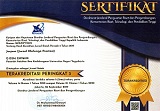Pengaruh latihan uchikomi osaekomi dan power lengan terhadap hasil osaekomi saat randori pada pejudo
DOI:
https://doi.org/10.21831/jorpres.v15i1.26026Keywords:
metode latihan uchikomi, power lengan, judo, hasil osaekomi.Abstract
Penelitian ini bertujuan untuk mengetahui: (1) perbedaan pengaruh antara metode uchikomi osaekomi berpasangan dan uchikomi bayangan terhadap hasil osaekomi saat randori, (2) perbedaan hasil osaekomi antara pejudo power lengan kuat dan power lengan lemah, (3) interaksi antara metode uchikomi osaekomi dan power lengan terhadap hasil osaekomi saat randori. Metode menggunakan eksperimen dengan rancangan faktorial 2 x 2. Populasi penelitian pejudo Daerah Istimewa Yogyakarta 44 pejudo. Sampel 24 pejudo dengan teknik purposive random sampling. Seluruh data diperoleh melalui tes power lengan dengan tes push up serta hasil osaekomi dengan randori selama empat menit. Teknik analisis data adalah ANAVA. Hasil penelitian menunjukkan: (1) ada perbedaan pengaruh yang signifikan antara latihan uchikomi dengan berpasangan dan uchikomi bayangan terhadap hasil osaekomi, (2) ada perbedaan yang signifikan hasil osaekomi antara pejudo yang memiliki power lengan kuat dan power lengan lemah, dan (3) ada interaksi antara metode uchikomi dan power lengan terhadap hasil osaekomi saat randori.
The effects of the exercise of uchikomi osaekomi and power arm on osaekomi results when randori judoka
Abstract
This research aims to find out: (1) the difference between the methods of uchikomi osaekomi effects in pairs and uchikomi shadow on the results of the current osaekomi randori, (2) the difference between the results of osaekomi judoka arm which has high power and low power arm, and (3) the interaction between the method of uchikomi osaekomi and power arm on the results when below randori osaekomi. This research is the experimental method with 2 x 2 factorial design. The research population was Judoka Special Region of Yogyakarta. amounting to 44 Judoka. The Sampel of this research were 24 Judoka taken with random purposive sampling technique. All data of this research was obtained through tests and measurements of arm power by using the push-up test and the results of osaekomi Randori (contested) for four minutes. The data analysis technique used is the Variant Analysis (ANAVA). The results show that: (1) there is a significant difference between the exercise of uchikomi by twos and shadow uchikomi on osaekomi results, (2) there is a significant difference between the results of osaekomi judo Judoka who have power high arm and lower arm power, and (3) there is an interaction between the method of uchikomi and power arm on the results of osaekomi while randori.
References
Bompa, T. (2009). Theory and metodology of training. Iowa: Kendall Hunt Publishing Company.
Broussal, A. (2010). Judo at international level is amazing it's one of the most competitive sports in the world. British: The British Olympic Team.
David K. M. (2002). Measurement by the physical educator why and how. Amerika: Mcgraw-Hill Companies.
Detanico, D, & Santos. S. G. (2012). Especific evaluation in judo: a review of methods. Journal of kinanthropomentry and human performance, 14(6).
Fadil, A. (2012). Pengaruh perbedaan sudut tolakan terhadap nilai power tungkai. Eprints.uny.ac.id. (diunduh tanggal 12 Februari 2015).
Franchini, E. (2015). Specificity of performance adaptations to a periodized judo training program. Journal of Science & Sports, Volume 8, Issue 2. Pages 67–72
Franchini, E. B., Ciro J. Fukuda., et al. (2014). The physiology of judo-specific training modalities. Journal of Strength & Conditioning Research, Volume 28 - Issue 5 - p 1474–1481.
Ghazali, A., Mansur, M., Widanita, N., Guntur, G., Putra, F., & Fajaruddin, S. (2019). Developing pilates training model for decreasing the body fat ratio among overweight women. ACTIVE: Journal of Physical Education, Sport, Health and Recreation, 8(1), 9-17. doi https://doi.org/10.15294/active.v8i1.27908
Hadi, S. (2002). Methodologi research. Yogyakarta: Andi Offside.
Imamura R. T, Hreljac A, Escamilla R. F, at al. (2006). A three-dimensional analysis of the center of mass for three different judo throwing techniques. USA: California State University Sacramento.
Irianto, D. P. (2002). Diktat dasar kepelatihan olahraga. Yogyakarya: Universitas Negeri Yogyakarta.
Irianto, D. P. (2004). Panduan latihan kebugaran (yang efektif dan aman). Yogyakarta: Lukman Offset. Fox E. L. (1984). Sport physiology, second.
Noors, A. M. (2000). Dasar-dasar judo. Jakarta: PT. Dian Rakyat.
Prayadi, H., & Rachman, H. (2013). Pengaruh metode latihan dan power lengan terhadap kemampuan smash bulutangkis. Jurnal Keolahragaan, 1(1), 63 - 71. doi:https://doi.org/10.21831/jk.v1i1.2346
Rahyubi, H. (2012). Teori-teori belajar dan aplikasi pembelajaran motoric diskripsi dan tinjauan kritis. Bandung: Nusa Media.
Sugiyono. (2005). Metode penelitian kuantitafif, kualitatif, dan R&D. Bandung: CV Alfabeta.
Suharjana. (2013). Kebugaran jasmani. Yogyakarta: Jogja Global Media.
Sukadiyanto. (2002). Teori dan metodologi melatih fisik petenis. Yogyakarta: Fakultas Ilmu Keolahragaan UNY.
Surachmad, W. (2003). Pengantar interaksi mengajar, belajar, dasar dan teknik metodologi pengajaran. Bandung: Tarsito.
Syah, M. (2003). Psikologi pendidikan dengan pendekatan baru. Bandung: Remaja Rosdakarya.
Yudiana, Y. (2009). Teori dan metode latihan. Jurnal.upi.edu. (diunduh 25 Juli 2014).
Downloads
Published
How to Cite
Issue
Section
License
Authors who publish with this journal agree to the following terms:
- Authors retain copyright and grant the journal right of first publication with the work simultaneously licensed under a Creative Commons Attribution License that allows others to share the work with an acknowledgement of the work's authorship and initial publication in this journal.
- Authors are able to enter into separate, additional contractual arrangements for the non-exclusive distribution of the journal's published version of the work (e.g., post it to an institutional repository or publish it in a book), with an acknowledgement of its initial publication in this journal.
- Authors are permitted and encouraged to post their work online (e.g., in institutional repositories or on their website) prior to and during the submission process, as it can lead to productive exchanges, as well as earlier and greater citation of published work (See The Effect of Open Access).




